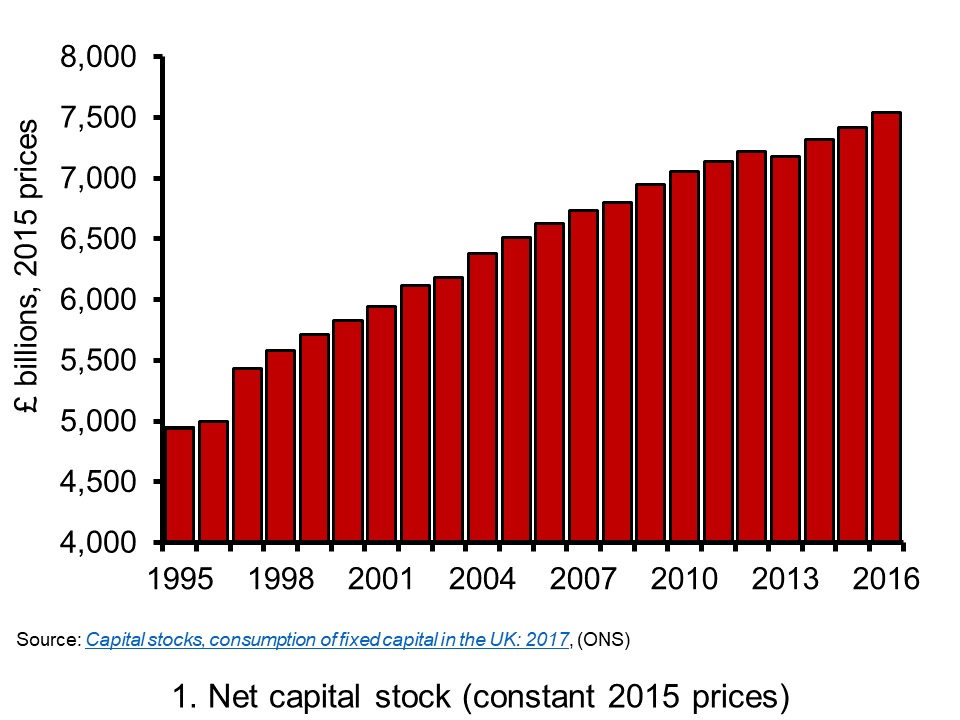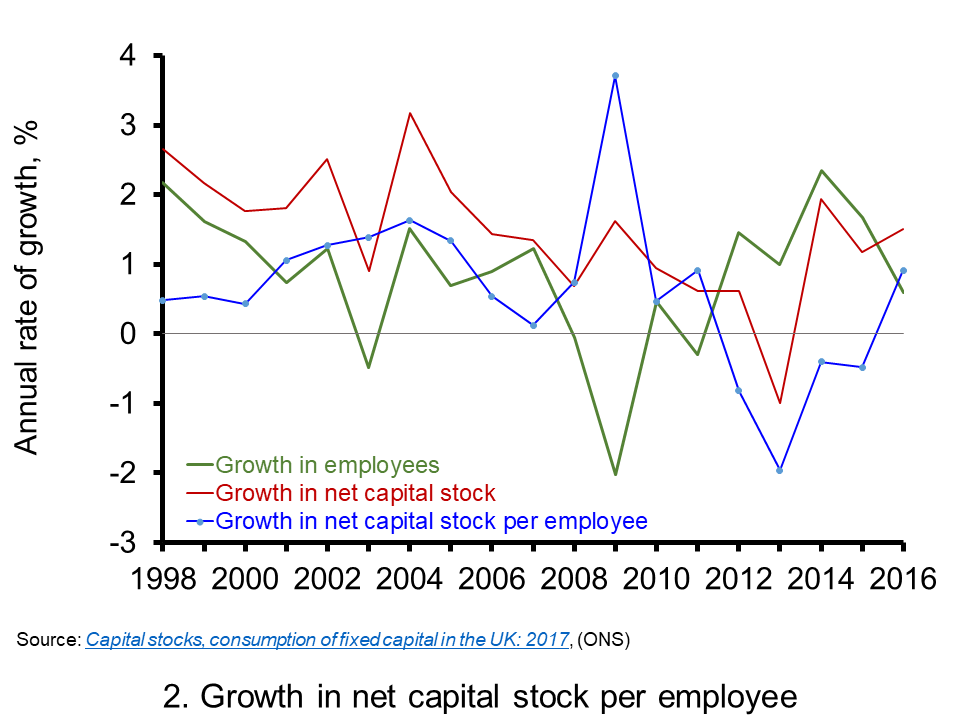Productivity needs its capital
 The UK is a productivity laggard. Compared to many developed countries over the recent past it has experienced weaker growth in output per worker and output per hour worked. This is detrimental to our longer-term well-being and to peoples’ living standards. An important contributory factor has been the weakness of growth in (non-financial) capital per worker. Recent ONS figures show that UK experienced a decline in capital per worker from 2012 to 2015, which was only ended in 2016.
The UK is a productivity laggard. Compared to many developed countries over the recent past it has experienced weaker growth in output per worker and output per hour worked. This is detrimental to our longer-term well-being and to peoples’ living standards. An important contributory factor has been the weakness of growth in (non-financial) capital per worker. Recent ONS figures show that UK experienced a decline in capital per worker from 2012 to 2015, which was only ended in 2016.
Non-financial capital assets (also known as fixed assets) are defined as already-produced, durable goods or any non-financial asset used in the production of goods or services. This includes items such as dwellings, buildings, ICT, machinery and transport equipment.
 Chart 1 shows the value of net capital assets in the UK since 1995. ‘Net’ figures account for the depreciation of assets and so reflect the market value of the capital stock. At the end of 2016 the net capital stock was estimated at £7.54 trillion (at 2015 prices) compared to £4.94 trillion (at 2015 prices) in 1995, an increase of 53 per cent or about 2.4 per cent per year.
Chart 1 shows the value of net capital assets in the UK since 1995. ‘Net’ figures account for the depreciation of assets and so reflect the market value of the capital stock. At the end of 2016 the net capital stock was estimated at £7.54 trillion (at 2015 prices) compared to £4.94 trillion (at 2015 prices) in 1995, an increase of 53 per cent or about 2.4 per cent per year.
However, as the chart shows, the rate of growth slowed markedly following the financial crisis of the late 2000s, averaging a mere 0.8 per cent per year since 2010. (Click here for a Powerpoint of the chart).
Capital intensity can be measured by the amount of capital per employee. Capital intensity is important because the growth in net capital per employee impacts on productivity. Its growth has an impact on the current effectiveness of capital and labour in production and on the future growth in potential output per employee.
 Chart 2 shows that, following the financial crisis, falling employment levels temporarily boosted the growth in net capital per employee. Then, as employment levels recovered and began growing again, the weakness in investment meant that net capital per employee began to fall.
Chart 2 shows that, following the financial crisis, falling employment levels temporarily boosted the growth in net capital per employee. Then, as employment levels recovered and began growing again, the weakness in investment meant that net capital per employee began to fall.
In 2016, as employment growth slowed, the now stronger flows of investment meant that, for the first time since 2011, net capital per employee was finally rising again. (Click here for a PowerPoint of the chart).
The persistent weakness experienced by UK in the growth of capital intensity in the 2010s is a drag on productivity and on supply-side growth. The weakness of UK productivity growth looks like remaining for some time one of the biggest economic challenges facing policymakers. Productivity needs its capital.
Articles
UK business investment on ice until more Brexit progress, warns BCC The Guardian, Richard Partington (11/12/17)
Budget 2017: Can Digital Plug The UK’s Productivity Gap? Hufttington Post, William Newton (27/11/17)
UK productivity estimates must be ‘significantly’ lowered, admits OBR The Guardian, Richard Partington and Phillip Inman (13/12/17)
UK productivity sees further fall BBC News (6/10/17)
Data
Capital stocks, consumption of fixed capital in the UK: 2017 ONS
Questions
- How might we measure productivity?
- Compose a list of items that are examples of non-financial (or fixed) capital.
- How can the growth of non-financial (or fixed) capital affect productivity?
- What is meant by capital intensity? Why is this concept important for long-term growth?
- What factors might affect the rate of capital accumulation? Are there interventions that governments can make to impact on the rate of capital accumulation?
- Discuss the possible reasons why the UK has become a productivity laggard.